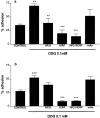Nitric oxide regulates human eosinophil adhesion mechanisms in vitro by changing integrin expression and activity on the eosinophil cell surface
- PMID: 11588118
- PMCID: PMC1572989
- DOI: 10.1038/sj.bjp.0704295
Nitric oxide regulates human eosinophil adhesion mechanisms in vitro by changing integrin expression and activity on the eosinophil cell surface
Abstract
1. The nitric oxide synthase (NOS) inhibitor, N(omega)-nitro-L-arginine methyl ester (L-NAME), inhibits both rat and human eosinophil chemotaxis in vitro. Here, the role of nitric oxide (NO) in human eosinophil cell surface integrin expression and function was investigated. 2. Human peripheral blood eosinophils were treated with L-NAME (0.01 - 1.0 mM) and their adhesion to human fibronectin and serum observed. Adhesion of cells to fibronectin and serum increased by 24.0+/-4.6 and 43.8+/-4.7%, respectively, when eosinophils were treated with 1.0 mM L-NAME. Increased adhesion by L-NAME could be abolished when cells were co-incubated with VLA-4- and Mac-1-specific monoclonal antibodies (mAbs). 3. The NO donor, sodium nitroprusside (2.5 mM), significantly inhibited eosinophil adhesion to fibronectin and serum by 34.3+/-4.5 and 45.2+/-5.6%, respectively. This inhibition was accompanied by a 4 fold increase in the levels of intracellular cyclic GMP. 4. Flow cytometrical analysis demonstrated that L-NAME induced an increased expression of CD11b (Mac-1) on the eosinophil cell surface of 36.3+/-7.4%. L-NAME had no effect upon CD49d (VLA-4) expression. 5. Treatment of human eosinophils, in vitro, with H-[1,2,4] oxadiazolo quinoxalin-1-one (ODQ) (0.1 mM), an inhibitor of soluble guanylate cyclase, also significantly increased eosinophil adhesion to fibronectin and serum by 73.5+/-17.9 and 91.7+/-12.9%, respectively. This increase in adhesion could also be inhibited by co-incubation with the Mac-1 and VLA-4-specific mAbs. 6. In conclusion, results indicate that NO, via a cyclic GMP-dependent mechanism, inhibits the adhesion of human eosinophils to the extracellular matrix (ECM). This inhibition is accompanied by a decrease in the expression and function of the eosinophil's adhesion molecules, in particular, the expression of the Mac-1 integrin and the function of the VLA-4 integrin.
Figures




Similar articles
-
Nitric oxide has a role in regulating VLA-4-integrin expression on the human neutrophil cell surface.Biochem Pharmacol. 2003 Jul 1;66(1):43-50. doi: 10.1016/s0006-2952(03)00243-0. Biochem Pharmacol. 2003. PMID: 12818364
-
Role of nitric oxide on in vitro human eosinophil migration.Biochem Pharmacol. 2001 Nov 15;62(10):1417-21. doi: 10.1016/s0006-2952(01)00782-1. Biochem Pharmacol. 2001. PMID: 11709202
-
Human eosinophil adhesion and degranulation stimulated with eotaxin and RANTES in vitro: lack of interaction with nitric oxide.BMC Pulm Med. 2008 Aug 12;8:13. doi: 10.1186/1471-2466-8-13. BMC Pulm Med. 2008. PMID: 18700028 Free PMC article.
-
Modulation of eosinophil migration from bone marrow to lungs of allergic rats by nitric oxide.Biochem Pharmacol. 2004 Aug 15;68(4):631-9. doi: 10.1016/j.bcp.2004.05.025. Biochem Pharmacol. 2004. PMID: 15276070
-
Expression and function of beta 1 integrins on human eosinophils.Mem Inst Oswaldo Cruz. 1997;92 Suppl 2:157-64. doi: 10.1590/s0074-02761997000800021. Mem Inst Oswaldo Cruz. 1997. PMID: 9698928 Review.
Cited by
-
cGMP modulation therapeutics for sickle cell disease.Exp Biol Med (Maywood). 2019 Feb;244(2):132-146. doi: 10.1177/1535370219827276. Epub 2019 Jan 28. Exp Biol Med (Maywood). 2019. PMID: 30691292 Free PMC article. Review.
-
Inhibition of phosphodiesterase 9A reduces cytokine-stimulated in vitro adhesion of neutrophils from sickle cell anemia individuals.Inflamm Res. 2011 Jul;60(7):633-42. doi: 10.1007/s00011-011-0315-8. Epub 2011 Feb 20. Inflamm Res. 2011. PMID: 21336703
-
Soluble guanylate cyclase-α1 is required for the cardioprotective effects of inhaled nitric oxide.Am J Physiol Heart Circ Physiol. 2011 Apr;300(4):H1477-83. doi: 10.1152/ajpheart.00948.2010. Epub 2011 Jan 21. Am J Physiol Heart Circ Physiol. 2011. PMID: 21257915 Free PMC article.
-
Role of cyclic GMP on inhibition by nitric oxide donors of human eosinophil chemotaxis in vitro.Br J Pharmacol. 2004 Feb;141(4):653-60. doi: 10.1038/sj.bjp.0705661. Epub 2004 Jan 26. Br J Pharmacol. 2004. PMID: 14744805 Free PMC article.
-
The roles of Akt and NOSs in regulation of VLA-4-mediated melanoma cell adhesion to endothelial VCAM-1 after UVB-irradiation.Arch Biochem Biophys. 2011 Apr 15;508(2):192-7. doi: 10.1016/j.abb.2010.11.021. Epub 2010 Dec 1. Arch Biochem Biophys. 2011. PMID: 21129359 Free PMC article.
References
-
- AGURA E.D., HOWARD M., COLLINS S.J. Identification and sequence analysis of the promoter for the integrin β-subunit (CD18): A retonoic acid-inducible gene. Blood. 1992;79:602–609. - PubMed
-
- BANICK P.D., CHEN Q., ANNE Xu Y., THOM S.R. Nitric oxide inhibits neutrophil β2 integrin function by inhibiting membrane-associated cyclic GMP synthesis. J. Cell. Physiol. 1997;172:12–24. - PubMed
-
- BELENKY S.N., ROBBINS R.A., RENNARD S.I., GOSSMAN G.L., NELSON K.J., RUBINSTEIN I. Inhibitors of nitric oxide attenuate neutrophil chemotaxis in vitro. J. Lab. Clin. Med. 1993;122:388–394. - PubMed
-
- CLANCY R., LESZCZYNSKA J., AMIN A., LEVARTOVSKY D., ABRAMSON S.B. Nitric oxide stimulates ADP ribosylation of actin in association with the inhibition of actin polymerization in human neutrophils. J. Leukoc. Biol. 1995;58:196–202. - PubMed
Publication types
MeSH terms
Substances
LinkOut - more resources
Full Text Sources
Other Literature Sources
Research Materials

